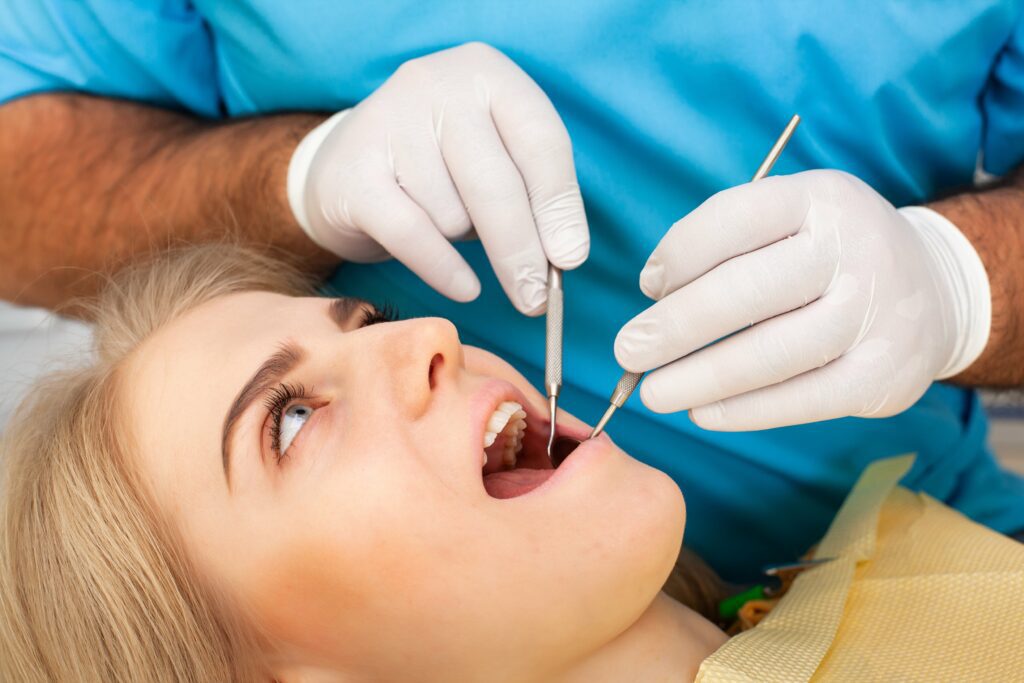White spots on teeth can be embarrassing and detract from your other healthy teeth. Thankfully, there are ways to both cover and treat these blemishes to achieve a healthier, whiter smile.

What are the Most Popular White Spot Treatments?
Option 1: ICON by DMG
The most effective way to treat white spots on teeth is to use ICON. During this white spot treatment, the damaged area receives a liquid composite infiltration that fills in the voids inside the weak, demineralized tooth. This process seals off the weaker areas, restoring the tooth to its natural color.
Overall, when it comes to treating white spots on teeth, ICON is by far the best choice. The procedure is quick, painless, and produces lasting results. No numbing or drilling is required. And ICON treats the specific area of concern without altering the healthy tooth structure around it.
Option 2: Microabrasion and Composite Bonding
For cases where ICON is not an appropriate treatment, microabrasion and composite bonding can be used to conceal and restore discolored teeth. Microabrasion removes the superficial enamel layer to completely lift out the white spot. Then, composite bonding is matched to the tooth and placed into that void and can last for several years before needing to be replaced.
Option 3: Veneers
Veneers are an extremely effective option to address white spots on teeth, as well as a host of other aesthetic concerns. Veneers can last for up to fifteen years and give you the freedom to choose the size, shape, and overall color of your entire smile.

Which Treatment is Best for White Spots on Teeth?
When it comes to treating white spots on teeth, ICON stands out as the preferred option for lasting and aesthetically pleasing results. Unlike microabrasion and composite bonding, this process is non-invasive and does not stain over time like other materials do. ICON is also far less invasive than veneers, as no natural tooth structures are altered during the treatment process.
What Causes White Spots on Teeth?
Hypocalcification
Enamel Hypocalcification is a common dental issue that results from a lack of calcium in the tooth enamel. This condition can cause the enamel to become weakened and susceptible to decay. As a result, white spots may appear on the teeth, indicating that the enamel has lost some of its mineral content. Poor oral hygiene, especially in cases where braces are present, can increase the likelihood of developing hypocalcification. It’s usually the result of plaque accumulation on the tooth, such as when orthodontic appliances aren’t cleaned well (leaving white circles or marks on your teeth after the braces are removed.)
Fluorosis
Enamel Fluorosis is a condition that results from excessive exposure to fluoride during tooth development. This can occur due to ingestion of fluoride through drinking from unregulated water sources or taking excessive supplements during childhood. The excess fluoride can cause the enamel to become discolored and develop white spots. To prevent fluorosis, it is important to monitor fluoride intake, especially in young children. Good oral hygiene practices, such as regular brushing and flossing, can also help to maintain the health of the teeth and prevent the development of fluorosis.
Enamel Hypoplasia
Enamel Hypoplasia is a condition that occurs when there is a disruption in the normal formation of tooth enamel. This can be caused by various factors, including certain medications such as tetracycline. Tetracycline, when taken during pregnancy or early childhood, can cause a disturbance in normal enamel formation, resulting in white spots on the teeth. Enamel hypoplasia can also cause the enamel to be thinner and more susceptible to damage, leading to an increased risk of tooth decay and other dental problems. To prevent enamel hypoplasia, it is important to maintain good oral hygiene and to be mindful of any medications that may affect the formation of the teeth.
White Spots on Teeth Q&A
Q: What are white spots on teeth?
White spots on teeth are a type of discoloration caused by enamel hypoplasia, fluorosis, or hypocalcification.
Q: How common are white spots on teeth?
White spots on teeth are quite common and are more prevalent in people with poor oral hygiene or who previously had orthodontic treatment.
Q: How can I prevent white spots on my teeth?
Good oral hygiene habits such as brushing, flossing, and using proper fluoride products and dosing can help to prevent the formation of white spots on teeth.
Q: What are the treatment options for white spots on teeth?
The most common treatment for white spots on teeth is the ICON system. This involves removing the white spots and infiltrating those areas with tooth-colored resin. Other treatments include microabrasion, composite bonding, and veneers.
Q: Is ICON safe?
Yes, ICON is a safe and effective treatment for white spots on teeth. It is minimally invasive and preserves the structure and integrity of the tooth.
Q: Is ICON a good choice for white spots on teeth?
Yes, ICON is a good choice for white spots on teeth because it removes the white spots without damaging the healthy enamel of the tooth.
Q: How long does it take for ICON to treat white spots on teeth?
The ICON system typically takes one appointment to complete. At that point, your dentist can determine how effective the resin filtration is and if additional procedures are necessary.
Q: How much does it cost to treat white spots on teeth with ICON?
The cost of ICON to treat white spots on teeth can vary depending on the complexity of the case and the geographic location of your dentist’s office. On average, ICON typically ranges between $500 and $1500.
Q: Is the ICON treatment painful?
No, the ICON treatment is not painful. It is minimally invasive and usually does not require any anesthetic.
Q: Is there an alternative to ICON for white spots on teeth?
Yes, there are other options for white spots on teeth, including microabrasion, composite bonding, and veneers. It is important to discuss the different treatment options with your dentist to find the best solution for you.





















